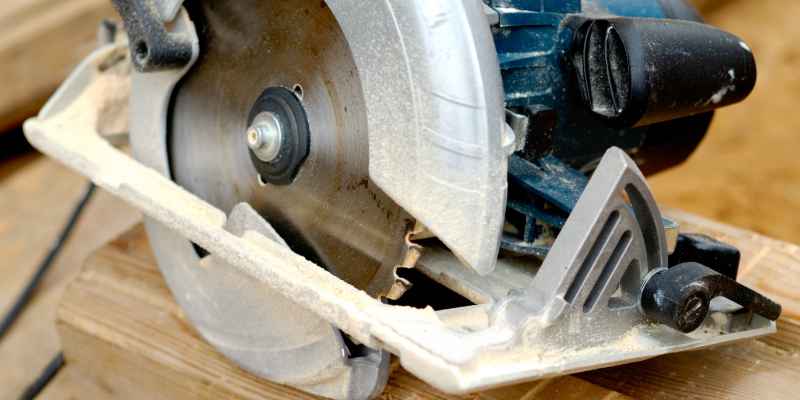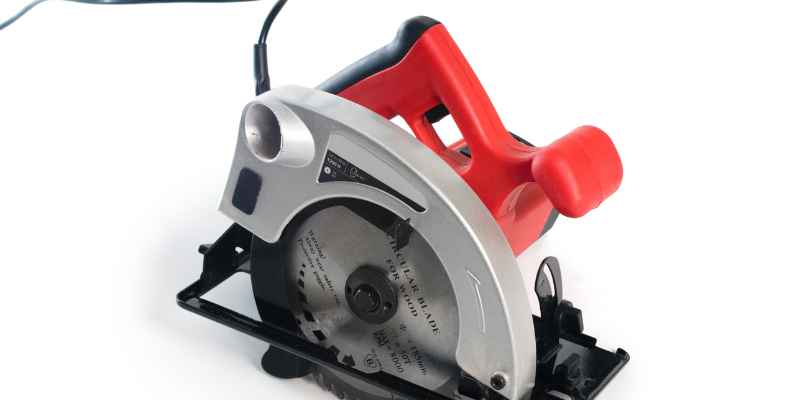The blade on a circular saw should be positioned with the teeth facing forward. We will discuss the importance and correct orientation of the blade on a circular saw.
We will also explore the potential risks associated with improper blade installation. Whether you are a DIY enthusiast or a professional carpenter, understanding the correct direction for the blade is essential for achieving accurate and safe cuts. So, let’s dive in and learn more about the proper placement of the blade on a circular saw.
Blade Orientation
When using a circular saw, it’s crucial to ensure that the blade is oriented correctly. The right way to position the blade on a circular saw is with the teeth facing forward. This orientation ensures proper cutting and minimizes the risk of accidents.
Proper Placement
When using a circular saw, it is crucial to ensure that the blade is properly oriented for optimal performance and safety. Knowing the correct placement of the blade can prevent potential accidents and help you achieve clean and precise cuts.
Before we delve into the proper placement of the blade, let’s first understand how a circular saw blade is designed. Most circular saw blades have teeth that are angled in one direction, typically facing forward. This design allows the blade to efficiently cut through various materials such as wood, plastic, or metal.
To install the blade correctly, follow these steps:
- Start by turning off the circular saw and unplugging it from the power source.
- Locate the blade locking mechanism on the saw and engage it to prevent any accidental start-up.
- Using the appropriate tool provided with your saw, loosen the arbor nut located in the center of the blade.
- Remove the old blade by sliding it off the arbor, taking note of the direction the teeth are facing.
- Place the new blade onto the arbor, ensuring that the teeth are facing in the direction you want to cut. Most circular saw blades indicate the correct direction on the blade itself.
- Tighten the arbor nut securely, but be careful not to overtighten, as it can cause damage to the blade and the saw.
By following these steps, you can rest assured that the circular saw blade is properly oriented for precise and safe cutting.
Incorrect Placement
Improper placement of the blade can lead to subpar cutting performance, increased risk of accidents, and potential damage to the saw and the material being cut.
Here are a few scenarios where the blade could be incorrectly placed:
- Installing the blade upside down: When the blade is mounted upside down, the teeth will face the wrong direction and will not efficiently cut through the material.
- Installing the blade with reverse teeth orientation: Some circular saw blades have teeth that alternate in direction. It is vital to ensure that the teeth are in the correct order, as mounting them out of sequence can result in rough and ineffective cuts.
Always double-check the orientation of the blade before starting any cutting project. It only takes a few moments, and it can save you time, effort, and potentially hazardous mishaps.

Understanding The Blade Direction
When it comes to using a circular saw, understanding the direction of the blade is crucial for safety and efficient cutting. The blade direction determines the way the saw will cut through the material, whether it is wood, metal, or masonry. In this article, we will elaborate on the two main blade rotations: clockwise and counterclockwise.
Clockwise Rotation
One way to determine the direction of the blade is by observing the rotation of the teeth. In a clockwise rotation, the teeth move in a clockwise direction as the blade spins. This rotation is specifically designed for standard circular saws and is the most common direction for cutting through various materials, particularly wood.
The clockwise rotation of the blade causes the saw to push the material away from the user, ensuring better control and reducing the chance of kickback. Kickback occurs when the saw binds or gets stuck in the material, causing it to jerk or move rapidly backward towards the user. By pushing the material away, this rotation minimizes the risk of kickback.
When using a circular saw with a clockwise rotation, the blade edge that faces upwards during the cut is the one with the teeth you can see. This configuration ensures a smooth and clean cut as the teeth are facing the material, effectively cutting through it.
Counterclockwise Rotation
Unlike the standard clockwise rotation, counterclockwise rotation is less common and mostly used in specialized circular saws, such as those designed for cutting specific materials like brick or stone. With counterclockwise rotation, the blade teeth move in a counterclockwise direction as the blade spins.
Similar to the clockwise rotation, counterclockwise rotation also pushes the material away from the user. This direction is necessary for cutting through materials like brick and stone because it prevents the blade from binding and helps maintain stability during the cut.
When using a circular saw with counterclockwise rotation, it is essential to ensure that the exposed blade edge facing upwards during the cut is the one that does not have visible teeth. This configuration ensures that the blade can effectively cut through the material without any obstruction or danger of kickback.
Conclusion
Understanding the blade direction in a circular saw is vital for safe and accurate cutting. Whether the blade rotates clockwise or counterclockwise, each direction serves a specific purpose for different materials. By being aware of the blade direction, you can make the most out of your circular saw and achieve precise results in your projects.
Importance Of Correct Blade Orientation
Safety is a crucial concern when using a circular saw, and the correct blade orientation plays a significant role in ensuring safe and effective operation. It is essential to understand the importance of the correct blade orientation to prevent accidents and achieve optimal cutting results.
Safety Considerations
Proper blade orientation is essential for minimizing the risk of kickback and blade binding, which can lead to severe injuries. A blade that is installed in the wrong direction can cause the saw to jerk or jump back toward the operator, posing a serious hazard. By ensuring that the blade is facing the correct way, users can significantly reduce the likelihood of accidents during operation.
Cutting Efficiency
Correct blade orientation also impacts cutting efficiency and the quality of the finished product. When the blade is positioned in the right direction, it ensures smooth and precise cuts, minimizing splintering and rough edges. This not only enhances the overall aesthetics of the cut but also improves the efficiency of the cutting process, saving time and effort.
Choosing The Right Blade For The Job
When it comes to using a circular saw, choosing the right blade for the job is crucial. Using the correct blade not only ensures clean and efficient cuts, but also improves safety and prevents damage to the saw itself. In this article, we will explore the different factors to consider when selecting a blade for your circular saw, and how to determine which way the blade should go.
Material-specific Blades
If you are working with different types of materials, such as wood, metal, or concrete, it is essential to use a blade specifically designed for that material. Material-specific blades are engineered with unique characteristics and features that allow them to cut through different materials with precision and ease.
For woodcutting tasks, you can choose from general-purpose blades, finish blades, or framing blades. General-purpose blades are versatile and suitable for cutting through different types of wood. Finish blades, on the other hand, are ideal for achieving smooth and clean cuts, making them perfect for fine woodworking projects. And if you are working on construction or carpentry projects that require cutting through thick and rough materials, framing blades are your best bet.
For metal cutting, you will need specialized blades designed specifically for metal. These blades are usually made of carbide or high-speed steel, which can withstand the high heat generated when cutting through metal. They also have a different tooth configuration, which allows them to cut through metal without getting damaged or worn out quickly. Make sure to select the appropriate blade for the specific type and thickness of the metal you are working with to ensure optimum results.
If you are dealing with concrete or masonry, diamond blades are the way to go. These blades feature diamond grits embedded in the cutting edge, which enable them to effortlessly cut through hard and abrasive materials like concrete, brick, and stone.
Teeth Configuration
The teeth configuration of a circular saw blade is another critical factor to consider when selecting the right blade for your job. The number of teeth and their shape can determine the quality of your cuts, the speed of cutting, and the type of material the blade is best suited for.
Blades with a higher tooth count are ideal for making smooth and clean cuts, as they have more teeth to distribute the cutting force evenly. These blades are often used for cutting through plywood, laminates, and other materials that require precise cuts.
On the other hand, blades with a lower tooth count are better suited for faster and rougher cuts. They are commonly used for ripping through thick and rough materials like lumber or for making crosscuts in construction projects. These blades have larger gullets between the teeth, allowing them to remove material quickly and efficiently.
Additionally, the shape of the teeth, such as alternate top bevel (ATB) or flat-top grind (FTG), can also affect the cutting performance. ATB blades are designed for cross-cutting tasks, providing a clean finish with their angled teeth. FTG blades, on the other hand, excel at ripping through materials, as their flat-top teeth can efficiently remove material in a straight line.
In conclusion, choosing the right blade for your circular saw is essential for optimal performance and safety. Material-specific blades and teeth configuration play a significant role in determining the blade’s suitability for the job at hand. By selecting the appropriate blade, you can ensure accurate cuts, efficient cutting speed, and prolong the lifespan of your circular saw.
Maintaining Blade Orientation
Blade orientation is crucial when using a circular saw, ensuring that the blade rotates in the right direction for optimal cutting performance and safety. Properly aligning the blade in accordance with the manufacturer’s instructions is essential for achieving accurate and efficient cuts.
Introduction
A circular saw is a powerful tool commonly used in woodworking and construction. One of the fundamental aspects of using a circular saw is maintaining the proper orientation of the blade. Knowing which way the blade goes and how to maintain its orientation is key to ensuring optimal performance and safety. In this section, we will explore the importance of maintaining blade orientation and provide you with practical tips to do so.
Regular Inspections
Regular inspections are crucial in maintaining the correct blade orientation on your circular saw. By inspecting the blade, you can detect any issues or misalignments that may compromise its performance. This will help you identify whether the blade is installed correctly or if any adjustments are required.
Proper Installation
Proper installation of the blade is vital to ensure its appropriate orientation on the circular saw. When installing the blade, make sure to follow these steps:
- Ensure the circular saw is unplugged from the power source and the blade is securely tightened in place.
- Examine the direction arrows printed on the blade. These arrows indicate the correct rotation direction of the blade.
- Align the arrows on the blade with the corresponding rotation direction arrow on the circular saw.
- Tighten the blade nut or screw to the manufacturer’s specifications, using the appropriate tool.
- Double-check that the blade is properly installed by gently rotating it with your hand to ensure it moves freely without any obstructions or wobbling.
By following these steps, you can be confident that the blade is correctly oriented and securely installed in your circular saw.

Frequently Asked Questions For Which Way Does The Blade Go On A Circular Saw
Which Way Do You Mount A Saw Blade?
To mount a saw blade, follow these steps:
1. Ensure the saw is unplugged and off.
2. Carefully remove the old blade.
3. Check the new blade’s rotation direction to match the saw’s arrow indicator.
4. Place the blade on the arbor, aligning the holes.
5. Tighten the blade with the arbor nut or bolt, ensuring it is secure before use.
How Do You Put A Blade On A Circular Saw?
To put a blade on a circular saw, first, unplug the saw. Then, retract the blade guard and loosen the arbor nut. Next, remove the old blade and place the new one, making sure it’s facing the right way. Finally, tighten the arbor nut and replace the blade guard.
Does A Saw Blade Go Clockwise Or Counterclockwise?
A saw blade can spin either clockwise or counterclockwise, depending on the type of saw.
Which Way Do You Use A Circular Saw?
To use a circular saw, start by aligning the saw’s blade with the cutting line. Hold the saw firmly and start the motor. Push the saw steadily through the material using a straight cutting motion. Ensure proper safety measures and wear protective gear while operating the saw.
Conclusion
In sum, understanding the correct way to place the blade on your circular saw is crucial for safety and efficiency in woodworking projects. By following the manufacturer’s guidelines and taking proper precautions, you can ensure a smooth and precise cutting process.
Remember, safety first and always use the right blade for the job!


